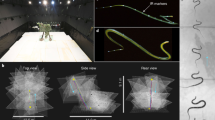Abstract
A snake, which has a simple shape without limbs, can move over rough terrain, climb a wall or tree, swim, and glide through the air. It is difficult to understand the gliding flight of a snake in aerodynamics assuming a static model, because a snake undulates its body trunk and turns in air. This paper presents an experimental system for investigation of the relationship between the shape of the gliding snake model and gliding characteristics. Results of a gliding experiment confirm a sufficiently high reproducibility of the experiment.












Similar content being viewed by others
References
Liljebäck P, Pettersen KY, Stavdahl Ø, Gravdahl JT (2012) A review on modelling, implementation, and control of snake robots. Robot Auton Syst 60:29–40
Takemori T, Tanaka M, Matsuno F (2018) Gait design for a snake robot by connecting curve segments and experimental demonstration. IEEE Trans Robot. https://doi.org/10.1109/TRO.2018.2830346
Rollinson D, Choset H (2014) Pipe network locomotion with a snake robot. J Field Robot 33(3):322–336
Sverdrup-Thygeson J, Kelasidi E, Pettersen KY, Gravdahl JT (2018) The underwater swimming manipulator—a bioinspired solution for subsea operations. IEEE J Ocean Eng. https://doi.org/10.1109/JOE.2017.2768108
Marcellini DL, Keefer TE (1976) Analysis of the gliding behavior of Ptychozoon lionatum (Reptilia: Gekkonidae). Herpetologica 1:362–366
McGuire JA, Dudley R (2005) The cost of living large: comparative gliding performance in flying lizards (Agamidae: Draco). Am Nat 166(1):93–106
Davenport J (1992) Wing-loading, stability and morphometric relationships in flying fish (Exocoetidae) from the north-eastern Atlantic. J Mar Biol Assoc UK 72(1):25–39
Andō M, Shiraishi S (1993) Gliding flight in the Japanese giant flying squirrel Petaurista leucogenys. J Mammal Soc Jpn 18(1):19–32
Socha JJ, O’Dempsey T, LaBarbera M (2005) A 3-D kinematic analysis of gliding in a flying snake, Chrysopelea paradisi. J Exp Biol 208(10):1817–1833
Krishnan A, Socha JJ, Vlachos PP, Barba LA (2014) Lift and wakes of flying snakes. Phys Fluids 26(3):1–19
Author information
Authors and Affiliations
Corresponding author
Additional information
This work was presented in part at the 2nd International Symposium on Swarm Behavior and Bio-Inspired Robotics, Kyoto, October 29–November 1, 2017.
About this article
Cite this article
Fujisawa, R., Tanaka, M. & Fujikawa, T. Development of an experimental system for a snake-like gliding model. Artif Life Robotics 23, 571–576 (2018). https://doi.org/10.1007/s10015-018-0490-6
Received:
Accepted:
Published:
Issue Date:
DOI: https://doi.org/10.1007/s10015-018-0490-6




